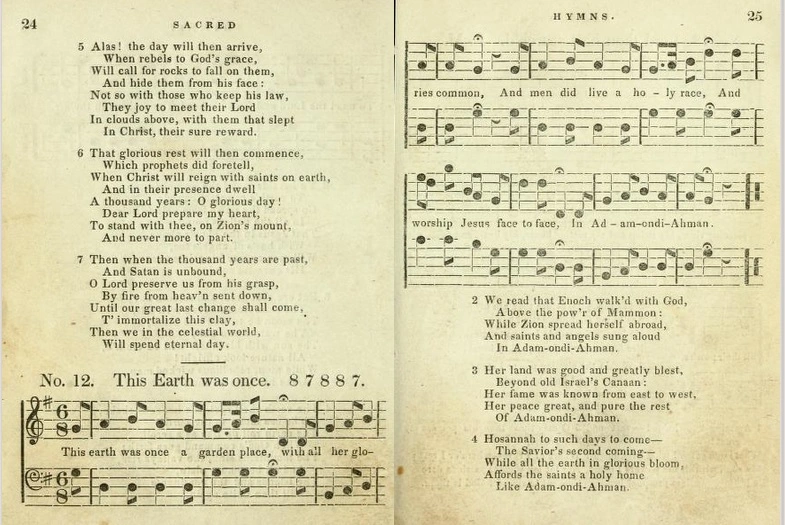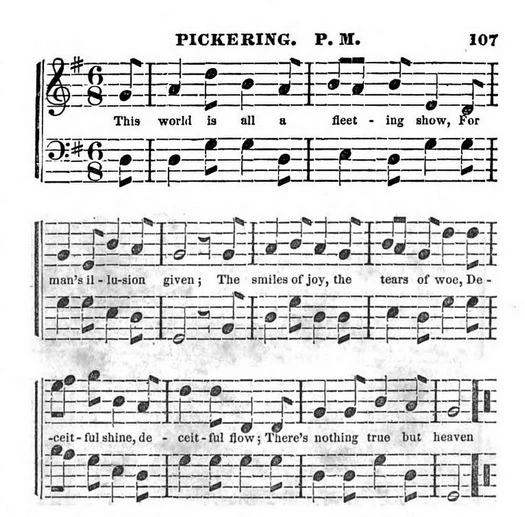“Adam-ondi-Ahman” (Hymn no. 49), sometimes known by its first line “This earth was once a garden place,” was first published in the June 1835 issue of the Latter Day Saints’ Messenger and Advocate and subsequently included in the first Latter-day Saint hymnal later that same year. As there was no musical notation in the early Latter-day Saint hymnals, it is impossible to say with any certainty which tune was originally sung with W. W. Phelps’ words. “Adam-ondi-Ahman” was one of six hymns sung at the dedication of the Kirtland temple on March 27, 1836, and according to the Messenger and Advocate, the tune to which it was sung on this occasion was also called ADAM-ONDI-AHMAN. Although the name suggests a newly composed tune, it is more likely the tune was borrowed from an unknown source, and the name changed.
The first Latter-day Saint hymnal to include musical notation was an unofficial collection published at Bellows Falls, Vermont, in 1844, entitled A Collection of Hymns for the use of the Latter Day Saints. In the “Bellows Falls hymnal,” as this book is often called, “This earth was once a garden place” is paired with a variation of the tune to which we sing these words today.

In the current Latter-day Saint hymnal this tune is named PROSPECT OF HEAVEN and its composer listed as anonymous, with the original source given as “Southern Harmony, 1835.” The Southern Harmony and Musical Companion, or Southern Harmony, as it was commonly known, was a popular shape-note hymnal compiled by William Walker, and first published at Spartanburg, South Carolina, in 1835. It is not known how the General Music Committee came up with this book as the source for their tune; in Southern Harmony PROSPECT OF HEAVEN clearly has a composer’s name printed above it: A. Grambling.

A further search of this collection finds four additional tunes attributed to Grambling, one of which gives his full name as the “Reverend Andrew Grambling.” (see hymn no. 289, “Come ye who love the lord indeed,” with the tune THE NARROW WAY).
However, Dr. Wade Kotter, a librarian at Weber State University and an independent hymn researcher, has discovered that the 1844 Latter-day Saint printing of this tune bears a striking resemblance to a tune named PICKERING as found in the Wesleyan Harp (1834), published one year before Southern Harmony.

Both tunes share similarities with the tune used by the Latter-day Saints. Grambling may have based his tune on PICKERING, or perhaps both were derived from an earlier, as-of-yet undiscovered tune. Unfortunately, the composer of PICKERING is not known. In any case, Grambling’s tune more closely resembles the Latter-day Saint tune in measure 9 and the first half of measure 10 (corresponding to the words “And empty dreams” in Southern Harmony, and the words “And worship Jesus” in measures 7 and 8 of the Latter-day Saint hymnal), while PICKERING is much closer in the final three measures.
This tune, as used today by the Latter-day Saints, has been slightly modified since its 1844 printing, and is closer in form to the 1880 version printed in Eliza R. Snow’s Tune Book for the Primary Associations of the Children of Zion.

It is uncertain if these alterations were made by Snow and Dr. Ellen B. Ferguson, who helped arrange the music for this collection, or if the tune had evolved on its own between 1844 and 1880.
Andrew Grambling (1783-1874)
Andrew Grambling (his surname name is sometimes spelled Gramling) was born in South Carolina on November 21, 1783. He joined the Methodist Episcopal Church on November 17, 1806, and two years later was appointed a class leader. He was ordained a deacon by Bishop William McKendree on December 25, 1812, at Charleston, South Carolina. “He was a great singer in his day,” and contributed several pieces of music to William Walker’s Southern Harmony, published at Spartanburg, South Carolina in 1835. He was married to Rebecca Foster, a daughter of John and Sidney Foster, on November 10, 1811. Gramling moved to Canton, Cherokee County, Georgia circa 1850, where he died on May 14, 1874.
Notes:
The original first line of this hymn, as published in the Messenger and Advocate, was “This world was once a garden place.” It was changed to “This earth was once a garden place” before the publication of the 1835 hymnal. This hymn may have been adapted from Thomas Moore’s “This world is all a fleeting show.” The first stanza of this hymn reads as follows:
This world is all a fleeting show
For man’s illusion given;
The smiles of joy, the tears of woe,
Deceitful shine, deceitful flow—
There’s nothing true but Heaven!
Sources:
W. W. Phelps, “Adam-ondi-Ahman,”Latter Day Saints’ Messenger and Advocate, June 1835, 144.
Latter Day Saints’ Messenger and Advocate, March 1836, 276-277.
J. C. Little and G. B. Gardner, A Collection of Sacred Hymns, for the use of the Latter Day Saints (Bellows Falls, Vermont: Blake and Bailey, 1844), 24-25.
L. S. Everett, Sacred Songs: Adapted to Social Religious Meetings, Sabbath Schools, and Family Worship (Boston: A. Tompkins, 1843), 107.
Eliza R. Snow, Tune Book for the Primary Associations of the Children of Zion (Salt Lake City: Juvenile Instructor Office, 1880), 28.
Wade Kotter, “This Earth Was Once a Garden Place (Adam-ondi-Ahman),” https://www.scoreexchange.com/scores/37514.html, accessed May 23, 2018.
Southern Christian Advocate (Macon, Georgia), November 11, 1874, 180.
“The Georgia Press,” Georgia Weekly Telegraph and Georgia Journal & Messenger (Macon, Georgia), June 02, 1874, [6].